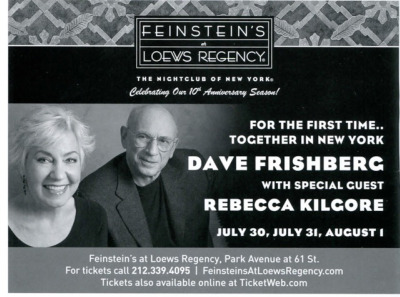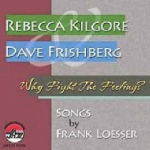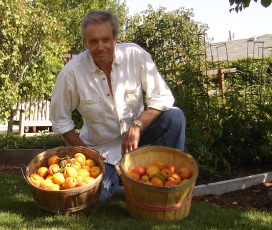Rifftides: July 2009 Archives
Pianist Bill Mays and the Oregon Festival of American Music Orchestra will perform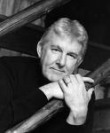 George Gershwin's Rhapsody in Blue tonight. Mays tells Rifftides it will be the full-blown composition that debuted in 1924 with Gershwin as soloist, not the shortened version frequently performed by symphony orchestras. For details, click here. If you happen not to be in Eugene, Oregon, you can hear it live in a web-streaming broadcast on KLCC-FM, Eugene's public radio station, at 8:00 pm PDT, 11 pm EDT. Click here, then click on either the MP3 or Windows Media player.
George Gershwin's Rhapsody in Blue tonight. Mays tells Rifftides it will be the full-blown composition that debuted in 1924 with Gershwin as soloist, not the shortened version frequently performed by symphony orchestras. For details, click here. If you happen not to be in Eugene, Oregon, you can hear it live in a web-streaming broadcast on KLCC-FM, Eugene's public radio station, at 8:00 pm PDT, 11 pm EDT. Click here, then click on either the MP3 or Windows Media player.
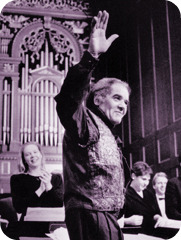 George Russell died Monday night. Here are some of the facts of his life, outlined by the Associated Press.
George Russell died Monday night. Here are some of the facts of his life, outlined by the Associated Press.
BOSTON (AP) -- Jazz composer George Russell, a MacArthur fellow whose theories influenced the modal music of Miles Davis and John Coltrane, has died. His publicist says Russell, who taught at the New England Conservatory, died Monday in Boston at age 86 of complications from Alzheimer's.
Russell was born in Cincinnati in 1923 and attended Wilberforce University. He played drums in Benny Carter's band and later wrote ''Cubano Be/Cubano Bop'' for Dizzy Gillespie's orchestra. It premiered at Carnegie Hall in 1947 and was the first fusion of Afro-Cuban rhythms with jazz. Russell developed the Lydian concept in 1953. It's credited as the first theoretical contribution from jazz.
Russell is survived by his wife, his son and three grandchildren. A release says a memorial service will be planned.
The first sentence of that AP story barely suggests Russell's importance. There will be much more written and spoken about him in the next few days by scholars and historians, as there should be. The work he did, particularly in the 1950s and '60s, had major influence on the thinking and performance of musicians who were shaping new ways of approaching the music. On a radio program I did in the sixties, I devoted five weeks of broadcasts to Russell's music. This was the introduction to that series on Jazz Review on WDSU-FM in New Orleans in September and October of 1966.
Over the next few programs we're going to consider the recorded work of George Russell - not only because Russell's music is interesting, absorbing listening, but also because of his influence of the development of jazz in the sixties, an influence, I believe, more profound and widespread than is generally recognized even by many musicians. It may well develop that Russell is having an impact on the course of jazz as great as, or greater than, that of such imitated innovators as John Coltrane and Ornette Coleman.Russell believes that jazz must develop on its own terms, from within. He believes that to borrow the concepts of classical music and force jazz into the mold of the classical tradition results in something perhaps interesting, perhaps Third Stream music, but not jazz. Faced with this conviction that jazz musicians must look to jazz for their means of growth, Russell set about creating a framework within which to work.
In 1953 he completed his Lydian Concept of Tonal Organization. The system is built on
what he calls pan-tonality, bypassing the atonal ground covered by modern classical composers and making great use of chromaticism. Russell explains that pan-tonality allows the write and the improviser to retain the scale-based nature of the folk music in which jazz has its roots, yet have the freedom of being in a number of tonalities at once. Hence, pan-tonality.
That's a brief and far from complete reduction of George Russell's theory, on which he worked for ten years. It's all in Russell's book, The Lydian Chromatic Concept of Jazz Improvisation.
Freedom within restrictions, however broad.
Discipline.
Improvising Russell's way demands great technical skill. Listening to his recordings, one is struck by the virtuoso nature of the players. Some of their names: Bill Evans, Paul Bley, Don Ellis, Dave Baker, John Coltrane, Art Farmer, Steve Swallow, Eric Dolphy.
Evans is featured soloist in Russell's 1959 Decca recording, Jazz In The Space Age, the most thorough application of Russell's theories to a large band. If you're not familiar with Russell, all that talk about concepts and theories and pan-tonality and chromaticism may have led you to expect something dry and formidable. On the contrary, there's a sense of fun and airiness in the music. The humor is subtle, but it's there. And, I should add, it's more evident after several hearings.
For five Saturdays, engineer Charlie Flatt played and I talked about Russell's music, reaching back to 1947 and his "Cubano Be-Cubano Bop" for Gillespie and up to his 1963 quintet album The Outer View. The survey included the classic "All About Rosie," commissioned by Brandeis University in 1957, the smalltet recordings for RCA, Russell's series of Riverside albums and the remarkable suite New York, New York, a 1959 work that brought together, among other players, Evans, Coltrane, Bob Brookmeyer, Art Farmer, and Phil Woods, all interesting young musicians who went on to be among the most influential in jazz.
For a sense of Russell and New York milieu in which he operated in the late 1950s, video of a 1958 edition of The Subject Is Jazz brings together several of the musicians who played his music. It includes a version of Rusell's "Concerto For Billy The Kid," with a Bill Evans solo not as electrifying as the one on this recording. Nonetheless, it presents Evans in the context of Russell's work, and it is followed by critic Gilbert Seldes interviewing Russell about his concept. The program also has two pieces featuring Billy Taylor. If you stay with it for all 24 minutes, you'll see credits for the musicians. And, yes the trumpeter identified as Carl Severinsen is Doc Severinsen. You may never have thought of him as a bebopper, but listen to those solos.
Was George Russell a force in opening jazz to greater freedom In the late fifties and early sixties, as I suggested 43 years ago, or did his Lydian Chromatic Concept synthesize ideas that were already in the air? Some of each, perhaps. Either way, he created some of the most stimulating music of his day, up to, including and beyond his collaboration with avant garde trumpeter Don Cherry. I am less enchanted with his later electronic works, but I'm going to dig them out and give myself another chance with them. After all, it's George Russell; there may be more than met the ear the first time around.
Following that 1966 series of radio programs about Russell, I sent him a transcript, not knowing whether he would ever see it. I heard reports from New York that he was discouraged and had left the US to live in Europe. A few months later he sent me a letter from Stockholm.
It is like I have waited a lifetime to hear someone say the things which you did concerning my music (and if I never hear them again I will not feel that my efforts in jazz have gone unrewarded). I received the transcript at the right moment, too, for I was in one of those states of flux that I've come to accept as a necessary but painful part of artistic growth. It is very trying during these times to keep one's self-confidence and I must admit that my morale was sagging more than a little bit. But your sensitive views of my music worked wonders.
Closing a long letter, Russell wrote that he hoped we would meet one day. We never did.
(For an obituary containing insights into Russell's methods see the article by Brian Marquard and Michael Bailey in today's Boston Globe)
I am not in the business of promoting night club engagements. Nor do I intend to be. However, this is so rare an event on the east coast, I would hate to think that Rifftides readers in and about New York might fail to hear about it.
As a companion unsolicited plug, allow me to call your attention to the most recent Kilgore-Frishberg collaboration on CD, Why Fight The Feeling, their collection of Frank Loesser songs. Full disclosure: I wrote the liner notes. I got paid, but I've spent the money, and I don't get royalties.
From the notes:
Loesser was a master at converting everyday language into lyrics that, as Frishberg put it, "Take the listener by the ear and lead him around." A fledgling songwriter in New York in the late 1950s, Frishberg got to know Loesser. He has never forgotten the guidelines the older man gave him:"Try to make everything refer back to the title. Make the lyric belong to the song, and the title should have something to do with it. Keep focused in on what the title is saying. He told me to avoid colorful language unless I put a rest nearby so that the audience could have time to digest it. Otherwise, they'd be admiring, or wondering, or puzzled about it and lose the next lyric or two, because the purpose of writing is to get their attention and keep it."
Anyone familiar with Frishberg's songs knows that Loesser's advice made an impression, but you'll have to consult Dave's recordings for evidence; the only songs here are his mentor's. In line with their long-time agreement, Dave doesn't sing when he and Becky perform together. That's only fair; she doesn't play piano when he sings.
Steve Kuhn, Mostly Coltrane (ECM). Kuhn pays homage to John Coltrane, who briefly employed him in 1960 when the pianist was on the doorstep of his career. His tribute  encompasses elegiac, earthy and wildly exploratory facets of the great saxophonist. It may remind listeners that, despite a relatively low profile, Kuhn is a major pianist of our time. His grasp of the nature, or natures, of Coltrane's music is evident throughout. His keyboard touch, his fluidity, the flow and density of his harmonies, the way he supports Joe Lovano, make that plain. Lovano is a saxophonist drenched in Coltrane's spirit who has the technique to summon it without resorting to either mindless direct imitation or the thrashing about that render so many Coltrane acolytes sterile. Bassist David Finck and drummer Joey Baron are connected with Kuhn and Lovano as if by neural attachment. Their accompaniment consists of not merely a carpet of rhythmic support underneath the piano and saxophone, but threads woven into the music.
encompasses elegiac, earthy and wildly exploratory facets of the great saxophonist. It may remind listeners that, despite a relatively low profile, Kuhn is a major pianist of our time. His grasp of the nature, or natures, of Coltrane's music is evident throughout. His keyboard touch, his fluidity, the flow and density of his harmonies, the way he supports Joe Lovano, make that plain. Lovano is a saxophonist drenched in Coltrane's spirit who has the technique to summon it without resorting to either mindless direct imitation or the thrashing about that render so many Coltrane acolytes sterile. Bassist David Finck and drummer Joey Baron are connected with Kuhn and Lovano as if by neural attachment. Their accompaniment consists of not merely a carpet of rhythmic support underneath the piano and saxophone, but threads woven into the music.
When I was in New York last month, one of my unanticipated treats was being taken to the ASCAP Jazz Wall of Fame Awards ceremony at Lincoln Center. The posthumous inductees included Coltrane. The artists ASCAP chose to represent his music were Kuhn and Lovano. Their exquisitely slow "Central Park West" was so mesmerizing that when it ended it kept the audience in suspended animation for what seemed a full minute before applause erupted. Judi Silvano, Lovano's wife, was sitting behind me. She leaned over and said, "You see why I married him." The "CPW" here is shorter, marginally faster and doesn't weave quite the spell of the duet that night in the Allen Room, but it is a lovely interpretation of one of Coltrane's most affecting pieces. In addition to "Crescent," "Like Sonny," "Spiritual" and six other Coltrane compositions, Kuhn provides two new pieces, the glistening unaccompanied piano solo "With Gratitude," and "Trance," with an appropriately hypnotic Lovano solo on the Hungarian instrument known as a tárogató.
To represent Coltrane's final days, when he was searching for what he called a "universal sound," Kuhn chose "Configuration," from the 1967 album Interstellar Space. Coltrane's recording was a chromatic exercise that developed into startling bursts of energy exchanges with drummer Rashied Ali. Kuhn's version follows the pattern, with Lovano approximating Coltrane's unbridled free will and passion and Baron demonstrating the full range of technique that he often keeps in reserve. Kuhn contributes a new element, a whirlpool of a piano solo. He is breathtaking in his technical control while taking advantage of the freedom to impose self discipline. Following a few bars of simultaneous improvisation with Lovano, Kuhn makes a spontaneous composition that has form and logic. Elliott Carter, George Crumb or any other modern concert composer might have spent weeks writing it and been happy to have done so. Kuhn creates it on the spot. Art Blakey was fond of saying, "Jazz musicians are the greatest musicians in the world." Kuhn's solo on "Configuration" is supporting evidence for that argument.
Steve Kuhn, Baubles, Bangles And Beads (Venus). Kuhn is one of several prominent pianists recording for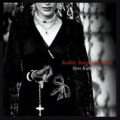 the Japanese label Venus, whose CDs until recently were available outside of Japan only as expensive imports. Now, Amazon.com offers them at moderate prices. In this trio recording, one of several he's done for the label, Kuhn, David Finck and drummer Billy Drummond explore themes by classical composers. Some of the pieces are in their original forms, among them a gutsier approach then we usually hear to Satie's "Gymnopedie No. 1." Kuhn and the trio also play Chopin's "Prelude In C-Minor, No. 20, Opus 28" and Lehar's venerable "Vilia" from The Merry Widow. Other tracks are standard songs adapted from the classics, including the title tune, "Stranger In Paradise," "'Til The End Of Time" and "If You Are But A Dream." Kuhn's waltz treatment of the third movement of the Brahms Symphony No. 3 has an amusing stop-time hesitation in the arrangement and one of several sterling Finck bass solos in the album. I am slightly bothered by Kuhn's frequent use of repeated triplet figures in his right-hand lines, which seems to have become a habit. That is a minor irritant in a CD overflowing with playing marked by lyricism, terrific chord alterations and irresistible swing.
the Japanese label Venus, whose CDs until recently were available outside of Japan only as expensive imports. Now, Amazon.com offers them at moderate prices. In this trio recording, one of several he's done for the label, Kuhn, David Finck and drummer Billy Drummond explore themes by classical composers. Some of the pieces are in their original forms, among them a gutsier approach then we usually hear to Satie's "Gymnopedie No. 1." Kuhn and the trio also play Chopin's "Prelude In C-Minor, No. 20, Opus 28" and Lehar's venerable "Vilia" from The Merry Widow. Other tracks are standard songs adapted from the classics, including the title tune, "Stranger In Paradise," "'Til The End Of Time" and "If You Are But A Dream." Kuhn's waltz treatment of the third movement of the Brahms Symphony No. 3 has an amusing stop-time hesitation in the arrangement and one of several sterling Finck bass solos in the album. I am slightly bothered by Kuhn's frequent use of repeated triplet figures in his right-hand lines, which seems to have become a habit. That is a minor irritant in a CD overflowing with playing marked by lyricism, terrific chord alterations and irresistible swing.
Eric Alexander, My Favorite Things (Venus). Tenor saxophonist Alexander has recorded several CDs for Venus. Here, with the rhythm section he favors, he applies his capacious sound and 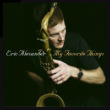 modern mainstream approach to "As Time Goes By," "Airegin," "Triste" and "Lover Man" in addition to the Richard Rodgers title tune and other standards. In years of working together Alexander, pianist David Hazeltine, bassist John Webber and drummer Joe Farnsworth have bonded into a tight quartet that avoids coasting even on the most familiar material. Alexander's spontaneous coda to Jobim's "Triste" is a nice surprise. Hazeltine, a complete pianist, is satisfying throughout. He and Alexnder are deep and thoughtful in a remarkably slow "Stella By Starlight," refreshing to hear after that perfect tune's having been converted by too many jazz players into a romp.
modern mainstream approach to "As Time Goes By," "Airegin," "Triste" and "Lover Man" in addition to the Richard Rodgers title tune and other standards. In years of working together Alexander, pianist David Hazeltine, bassist John Webber and drummer Joe Farnsworth have bonded into a tight quartet that avoids coasting even on the most familiar material. Alexander's spontaneous coda to Jobim's "Triste" is a nice surprise. Hazeltine, a complete pianist, is satisfying throughout. He and Alexnder are deep and thoughtful in a remarkably slow "Stella By Starlight," refreshing to hear after that perfect tune's having been converted by too many jazz players into a romp.
From Johnny Griffin With Love (Storyville). The three CDs in this box have some of Griffin's best work for the Danish label. The fourth disc is a DVD with performances by Griffin at New York's Village Vanguard and his fellow tenor saxophonist Eddie Lockjaw Davis at Copenhagen's Jazzhaus Sluketter, both with quartets. In the first CD Griffin is with the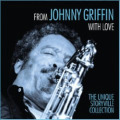 redoubtable rhythm section of pianist Kenny Drew, bassist Niels-Henning Ørsted Pedersen and drummer Arthur Taylor in 1964 at the Montmarte Jazzhouse in Copenhagen. The second disc, twenty years later at the same club, pairs Griffin with Davis, his favorite tenor sax sparring partner. Pianist Harry Pickens, bassist Curtis Lundy and early in his career, drummer Kenny Washington, are the support troops. On his own, Griffin is formidable, blazing with speed, chops and fluid ideas. When he and Davis team up, he becomes even more speech-inflected and, sometimes, confrontational in his soloing. They were one of the most stimulating and exciting horn duos in all of jazz, and their live performance together in this 1964 club date is a highlight of their partnership. With Drew again and with Jens Melgaard and Ole Streenberg on bass and drums in 1989, relatively late in his career Griffin had lost nothing of technique, drive or imagination. Griffin came to love and excel at ballads, and this third disc in the set has moving performances of Ralph Rainger's "If I Should Lose You" and Billy Strayhorn's "Isfahan." It closes with an extremely fast version of Thelonious Monk's "Rhythm-a-ning" that Griffin chooses as an occasion for not only several fearsome choruses but also a series of silly and thoroughly enjoyable whoops, hollers and a few honks.
redoubtable rhythm section of pianist Kenny Drew, bassist Niels-Henning Ørsted Pedersen and drummer Arthur Taylor in 1964 at the Montmarte Jazzhouse in Copenhagen. The second disc, twenty years later at the same club, pairs Griffin with Davis, his favorite tenor sax sparring partner. Pianist Harry Pickens, bassist Curtis Lundy and early in his career, drummer Kenny Washington, are the support troops. On his own, Griffin is formidable, blazing with speed, chops and fluid ideas. When he and Davis team up, he becomes even more speech-inflected and, sometimes, confrontational in his soloing. They were one of the most stimulating and exciting horn duos in all of jazz, and their live performance together in this 1964 club date is a highlight of their partnership. With Drew again and with Jens Melgaard and Ole Streenberg on bass and drums in 1989, relatively late in his career Griffin had lost nothing of technique, drive or imagination. Griffin came to love and excel at ballads, and this third disc in the set has moving performances of Ralph Rainger's "If I Should Lose You" and Billy Strayhorn's "Isfahan." It closes with an extremely fast version of Thelonious Monk's "Rhythm-a-ning" that Griffin chooses as an occasion for not only several fearsome choruses but also a series of silly and thoroughly enjoyable whoops, hollers and a few honks.
As the DVD opens, we hear the rhythm section of pianist Ronnie Matthews, bassist Ray Drummond and drummer Kenny Washington wailing on a fast blues in F as we watch pedestrian and auto traffic on Seventh Avenue outside the Vanguard. The camera takes us inside. Griffin launches into chorus after chorus of impassioned playing and Matthews follows suit with some of the best recorded soloing of his career. Drummond and Washington are in the same groove--and the same league. This version of Griffin's "A Monk's Dream," 13-and-a-half-minutes long without a superfluous note, is a triumph. The two tunes on Davis's portion of the DVD, recorded in 1985, feature drummer Ed Thigpen, the stalwart bassist Jesper Lungaard and Niels Jørgen Steen, a fine journeyman Danish pianist. Thigpen and Lundgaard clearly enjoy their relationship, Steen plays good solos, and Davis is at his usual high level, which is to say gruff, warm and swinging. The camera work, direction and sound reproduction are superb. The video is slightly grainy when viewed on a big screen, but that is a minor flaw to which the eye adjusts and is not a problem on an average-sized computer screen. These are honest, ungimmicked, portrayals of jazz bands at work and constitute one of the best jazz videos ever. When the DVD ends, the viewer has been present at two memorable performances.
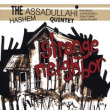 Hashem Assadullahi, Strange Neighbor (8bells). Assadullahi, a composer and saxophonist who lives in Oregon, bases six of his pieces on "actual and fictional" people in the Texas neighborhood where he grew up. The ten tracks have variety that runs from attractive melodies to free playing, slapstick humor, 1920s German cabaret kitsch and what could pass for part of the soundtrack of an Italian Western. Assadulahi's front-line partner in the quintet is trumpeter Ron Miles, a flexible and imposing presence throughout. The writing, now legato and thoughtful, now pointillist and scattered, is integrated with occasionally unfettered collective improvisation by the horns, guitarist Justin Morell, bassist Josh Tower and drummer Jason Palmer. Miles is from Denver. The members of the rhythm section are stalwarts of the Portland jazz community. This is a substantial debut album for Assadullahi.
Hashem Assadullahi, Strange Neighbor (8bells). Assadullahi, a composer and saxophonist who lives in Oregon, bases six of his pieces on "actual and fictional" people in the Texas neighborhood where he grew up. The ten tracks have variety that runs from attractive melodies to free playing, slapstick humor, 1920s German cabaret kitsch and what could pass for part of the soundtrack of an Italian Western. Assadulahi's front-line partner in the quintet is trumpeter Ron Miles, a flexible and imposing presence throughout. The writing, now legato and thoughtful, now pointillist and scattered, is integrated with occasionally unfettered collective improvisation by the horns, guitarist Justin Morell, bassist Josh Tower and drummer Jason Palmer. Miles is from Denver. The members of the rhythm section are stalwarts of the Portland jazz community. This is a substantial debut album for Assadullahi.
• Overkill word of the day, perhaps the decade: Absolutely.
This week on The News Hour on PBS television, nearly every person interviewed began answers to a total of approximately 150 questions with, "Absolutely. " That frequency, from educated people discussing policy issues, is typical at all levels of public and private life.
Perhaps we can bring back "yes."
• Inapt phrase of the day, perhaps the century: No Problem.
Ask for more water in a restaurant and the waiter says, "No problem." Tell the supermarket cashier "Thank you," and she says, "No problem." Extreme example: the other day I wished a passerby a good morning. He replied, "Hey, no problem."
This is getting out of hand.
Larry Bunker's versatile drumming, vibes playing and skill as an all-'round percussionist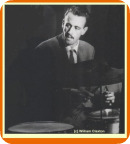 put him in demand by jazz players, symphony conductors, film and television studios, and singers. He worked with an array of artists that included Gerry Mulligan, Pierre Boulez, Peggy Lee, Judy Garland, Dizzy Gillespie, Gary Burton and Michael Tilson Thomas. In the mid-sixties, Bunker (1928-2005) took time to fill an ambition. For years, he had dreamed of playing with Bill Evans, and for a year or so left his lucrative first-call Los Angeles life to go on the road and record with Evans' trio.
put him in demand by jazz players, symphony conductors, film and television studios, and singers. He worked with an array of artists that included Gerry Mulligan, Pierre Boulez, Peggy Lee, Judy Garland, Dizzy Gillespie, Gary Burton and Michael Tilson Thomas. In the mid-sixties, Bunker (1928-2005) took time to fill an ambition. For years, he had dreamed of playing with Bill Evans, and for a year or so left his lucrative first-call Los Angeles life to go on the road and record with Evans' trio.
In this performance with Evans and bassist Chuck Israels, we hear--and see--why Bunker was so highly regarded for his playing with brushes. Following a rapid version of "Israel" and BBC-TV host Humphrey Lyttleton's farewell, Evans ends with his "I Got Rhythm" variant called "Five," toward the end working in a few bars each of "The Theme" and "Taps Miller." Throughout, he and Israels have spirited exchanges with Bunker.
Today is Billy Taylor's 88th brthday. It has not gone unnoticed by his publicists that, coincidentally, the piano has 88 keys. Appropriately, they have posted on his web site 88 videos of Taylor playing in a variety of contexts; speaking informatively on CBS Sunday Morning, where for years he did commentary; and being interviewed by Charles Kuralt, Charlie Rose, Charles Osgood and William F. Buckley, Jr., among others.
It is worth noting that Taylor and Dave Brubeck have long maintained a mutual admiration society. Brubeck is also 88, and one of those web site videos brings us the two of them playing 176 keys. Michael Moore is the bassist, Randy Jones the drummer.
"Take The 'A' Train," which you just heard, was Duke Ellington's theme song. Taylor and Brubeck were guest pianists at the 70th birthday party President Richard Nixon threw for Ellington at the White House in 1969. I happened to be standing nearby at the afternoon rehearsal in the East Room when a photographer asked the two of them to pose together. Taylor said, "Sure, something might rub off," eliciting a wide grin from Brubeck.
Happy Birthday, Billy.
To those who who knew Russ Freeman or his work it was a source of frustration that he elected during his final years not to play the piano. Freeman died in 2002 at the age of 76. He was part of the west coast jazz scene before it was called that. He worked in Los Angeles in the late forties and early fifties with Howard McGhee, Charlie Parker, Dexter Gordon and other bop musicians. Then he got famous as the pianist in Chet Baker's first quartet and attracted a following for his inventive work with Baker as accompanist, soloist and composer. Freeman wrote one of the classic jazz ballads, "The Wind," in addition to "Maid in Mexico," "Happy Little Sunbeam" "Fan Tan," "Band Aid" and pieces titled for his love of baseball, among them "Batter Up," "Safe at Home" and "Fungo.". Freeman recorded one trio album of his own and made a stunning two-piano album with André Previn. He collaborated closely with drummer Shelly Manne in Manne's quintet and two remarkable sets of piano-drum duets, one in 1954, another in 1982.
A concert that Freeman played in Vancouver, British Columbia, in 1959 has emerged on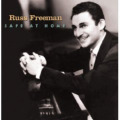 a new CD. The ten tracks remind us of his stimulating blend of lyricism and percussiveness. The repertoire includes includes standards, with an intriguing "Lush Life," a stirring "With a Song in My Heart" and a live version of "Fan Tan." The bassist and drummer are not identiied. This is a substantial addition to the sparse discography of Freeman as leader and a reminder of the muscle and drive in his solo work.
a new CD. The ten tracks remind us of his stimulating blend of lyricism and percussiveness. The repertoire includes includes standards, with an intriguing "Lush Life," a stirring "With a Song in My Heart" and a live version of "Fan Tan." The bassist and drummer are not identiied. This is a substantial addition to the sparse discography of Freeman as leader and a reminder of the muscle and drive in his solo work.
Thanks to Wolfram Knauer of Jazzinstitut Darmstadt in Germany for calling my attention to an article in the Las Vegas Sun about Carolyn Freeman. Russ Freeman's widow is at the center of a movement to create a jazz performance center in that Nevada city. In the course of the piece, she is quoted about her husband's reluctance to perform.
Though he was a great musician, her husband never listened to music at home, she says.
"He focused so hard when he listened it wasn't relaxing," Freeman says. "He couldn't tune it out. He'd hear the scores in movies. At a particularly dramatic moment he'd say, 'Carolyn, listen to that string line,' and it blows the whole movie."The Northridge earthquake in 1994, which killed 72 and injured thousands, drove the Freemans out of Los Angeles, and they ended up in Las Vegas. Both were retired by then.
"He didn't play music anymore," she says. "I asked him, 'Why don't you play? It's your gift?' And he said, 'It's very painful.' Russ was a perfectionist. He said, 'When the music is wonderful, it's unbelievable, but most of the time it's not.' "
To read all of the piece about Carolyn Freeman, go here.
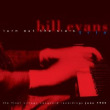 Bill Evans, Turn Out The Stars: The Final Village Vanguard Recordings (Nonesuch). This six-CD box set has kicked up a fuss lately on several blogs and web sites. The great pianist was dying when he recorded it. That knowledge informs the way critics hear the music he made with his trio at the Vanguard in June, 1980. Their arguments about artistic ascent or decline are fascinating. But the music is what matters, and the music is magnificent. This would be an essential item even if the price were not about half that of the original edition.
Bill Evans, Turn Out The Stars: The Final Village Vanguard Recordings (Nonesuch). This six-CD box set has kicked up a fuss lately on several blogs and web sites. The great pianist was dying when he recorded it. That knowledge informs the way critics hear the music he made with his trio at the Vanguard in June, 1980. Their arguments about artistic ascent or decline are fascinating. But the music is what matters, and the music is magnificent. This would be an essential item even if the price were not about half that of the original edition.
In the center exhibit under the legend Doug's Picks you will find new recommendations assembled by the Rifftides staff. They include CDs, a DVD and a book. They are by:
•A great pianist in the creative burst of his last days
•A bassist eschewing hybridized jazz for the straight but not narrow
•Another bassist, who sings as well as she plays
•A trumpeter at the beginning of what may turn out to be a significant career
•A composer with a keen ear, assessing his fellow composers
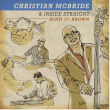 Christian McBride & Inside Straight, Kind of Brown (MackAvenue). The bassist sets aside his fascination with rock, hip-hop and electronica to cruise the mainstream. He uses only his acoustic bass. The music is latterday bebop, with a few modal tinges. Alto saxophonist Steve Wilson, always impressive, is at a peak here. His unison lines with young vibraphonist Warren Wolf are an attractive element. Eric Reed and Carl Allen are on piano and drums. After nine tracks of hard swinging, McBride picks up his bow to beautifully intone the melody of Jimmy McHugh's "Where Are You?"
Christian McBride & Inside Straight, Kind of Brown (MackAvenue). The bassist sets aside his fascination with rock, hip-hop and electronica to cruise the mainstream. He uses only his acoustic bass. The music is latterday bebop, with a few modal tinges. Alto saxophonist Steve Wilson, always impressive, is at a peak here. His unison lines with young vibraphonist Warren Wolf are an attractive element. Eric Reed and Carl Allen are on piano and drums. After nine tracks of hard swinging, McBride picks up his bow to beautifully intone the melody of Jimmy McHugh's "Where Are You?"
The following exchange showed up on the Jazz West Coast listserve today. It was attributed to Bill Crow's book Jazz Anecdotes, although I couldn't find it there. Wherever it's from, it deserves wide exposure.
"How late does the band play?"
"About half a beat behind the drummer."
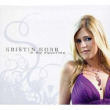 Kristin Korb, In The Meantime (KK). In the nature of things, attention will go to Korb's vocals and her glamorous makeover illustrated in the cover shots. Serious listeners will also be drawn to her bass playing. She accompanies herself as she sings with pianist Llew Matthews, saxophonist Bob Sheppard, guitarist Larry Koonse, drummer Steve Barnes and vibist Nick Mancini. She solos impressively on "Ain't Misbehavin'," adapts James Brown's "I Feel Good" to introduce Bob Dorough's "Better Than Anything," finds joy in "I Got It Bad" and introduces her intriguing ballad "If I Am Ever Yours."
Kristin Korb, In The Meantime (KK). In the nature of things, attention will go to Korb's vocals and her glamorous makeover illustrated in the cover shots. Serious listeners will also be drawn to her bass playing. She accompanies herself as she sings with pianist Llew Matthews, saxophonist Bob Sheppard, guitarist Larry Koonse, drummer Steve Barnes and vibist Nick Mancini. She solos impressively on "Ain't Misbehavin'," adapts James Brown's "I Feel Good" to introduce Bob Dorough's "Better Than Anything," finds joy in "I Got It Bad" and introduces her intriguing ballad "If I Am Ever Yours."
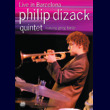 Philip Dizack Quintet Live In Barcelona Featuring Greg Tardy (Fresh Sound). Dizack, from Milwaukee, Wisconsin, was 20 when he played a club during the 2005 Barcelona Jazz Festival. Fresh Sound Records was on hand with a camera crew to capture a trumpeter with a huge sound, audacity and polished technique tempered by taste and imagination. Pianist Miro Sprague, bassist Pere Loewe and drummer Obed Calvaire appear to be only slightly older than Dizak. Tenor saxophonist Greg Tardy, 39 at the time, is the grizzled veteran of the group. Superb sound, camera work and direction put the viewer virtually on stage for an exhilarating performance by a tightly integrated band.
Philip Dizack Quintet Live In Barcelona Featuring Greg Tardy (Fresh Sound). Dizack, from Milwaukee, Wisconsin, was 20 when he played a club during the 2005 Barcelona Jazz Festival. Fresh Sound Records was on hand with a camera crew to capture a trumpeter with a huge sound, audacity and polished technique tempered by taste and imagination. Pianist Miro Sprague, bassist Pere Loewe and drummer Obed Calvaire appear to be only slightly older than Dizak. Tenor saxophonist Greg Tardy, 39 at the time, is the grizzled veteran of the group. Superb sound, camera work and direction put the viewer virtually on stage for an exhilarating performance by a tightly integrated band.
Graham Collier, The Jazz Composer: Moving Music Off The Paper (Northway). The title reads like that of a textbook, but this evaluation of the art is accessible to any layman with ears. Contradicting conventional wisdom about some composers, Collier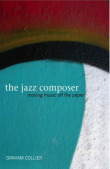 nudges Thad Jones from his pedestal, for instance, and shrugs off Bill Holman with minor praise. He puts in perspective Ellington's habit of borrowing and praises Gil Evans nearly without reservation. Whether or not you agree with Collier, he backs his positions with evidence and references and makes readers think hard about what they listen to. This is an important book.
nudges Thad Jones from his pedestal, for instance, and shrugs off Bill Holman with minor praise. He puts in perspective Ellington's habit of borrowing and praises Gil Evans nearly without reservation. Whether or not you agree with Collier, he backs his positions with evidence and references and makes readers think hard about what they listen to. This is an important book.
The newest addition to jazz.com's "The Dozens" series is Bill Kirchner's recommendation of twelve tracks by pianist Denny Zeitlin. Five of the pieces appear in the new Mosaic compendium of Zeitlin's 1960s trio recordings for Columbia. The others are from single albums, some available, others rare. Typical of Kirchner's keen musician's guidance through the tracks is this evaluation of Zeitlin's "Stonehenge:"
of Zeitlin's 1960s trio recordings for Columbia. The others are from single albums, some available, others rare. Typical of Kirchner's keen musician's guidance through the tracks is this evaluation of Zeitlin's "Stonehenge:"
This modal burner deserves to be more widely performed. One reason it isn't probably has to do with a complex polyrhythmic interlude that requires an authoritative lead sheet to be executed properly. Since Denny Zeitlin's own lead sheet isn't commercially available (I have a copy, and trust me, it's not music you'd want to transcribe), that leaves the piece in limbo.
From a listener's standpoint, though, this is a compelling performance, and one of Zeitlin's earliest indications of his gifts as a composer. It has McCoy Tyner-esque sturm und drang, but Zeitlin's vocabulary is quite different and gives his improvisation a character of its own. The climax is (drummer) Freddie Waits' solo over a roaring vamp by Zeitlin and (bassist) Cecil McBee.
From this listener's standpoint, that sort of guidance is helpful. Perhaps it will be to you, too. To read the whole thing, go here. You may find that Kirchner's article works hand-in-hand with a piece I wrote about Zeitlin in The Wall Street Journal last March.
Bobby Shew's Breakfast Wine is so rare that it does not appear in the Shew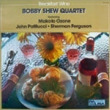 discography on the trumpeter's own web site. Nonetheless, the PAUSA long-playing vinyl album released in 1985 is a highlight not only of Shew's recording career but also of all jazz releases in the last two decades of the twentieth century. I lost my copy of Breakfast Wine in a move, so when I was rummaging through the used LP bin in a Seattle store the other day and came across a pristine copy, I gave a whoop. That prompted another customer to amble over and see what the fuss was about. I showed him the cover. He stared at it blankly and went back to the rock section. Good. I didn't want to have to fight him for the LP.
discography on the trumpeter's own web site. Nonetheless, the PAUSA long-playing vinyl album released in 1985 is a highlight not only of Shew's recording career but also of all jazz releases in the last two decades of the twentieth century. I lost my copy of Breakfast Wine in a move, so when I was rummaging through the used LP bin in a Seattle store the other day and came across a pristine copy, I gave a whoop. That prompted another customer to amble over and see what the fuss was about. I showed him the cover. He stared at it blankly and went back to the rock section. Good. I didn't want to have to fight him for the LP.
Shew's rhythm section on the record included the stalwart drummer Sherman Ferguson, pianist Makoto Ozone and bassist John Patitucci. Ozone and Patitucci were in their early twenties, at the launch points of their substantial careers. They shared with Shew the enthusiasm he had rekindled after deciding to walk away from his career of lead trumpet work with Woody Herman, Buddy Rich and other big bands, and from the Hollywood studios in which he had spent hundreds of lucrative hours.
"After all the Woodys and Mork and Mindys," he told the liner note writer (full disclosure: I was the liner note writer), "I realized I wasn't doing what makes the hair stand up on  the back of my neck. So I threw it all over, and now I'm playing jazz in clubs and doing clinics for student musicians about 200 days a year. I don't make the kind of money I used to as a studio musician. But I love everything I do. It's a self-inflicted eccentricity. And I've discovered it works not only in an artistic sense, but in a business sense too. I'm doing what I love and life is good."
the back of my neck. So I threw it all over, and now I'm playing jazz in clubs and doing clinics for student musicians about 200 days a year. I don't make the kind of money I used to as a studio musician. But I love everything I do. It's a self-inflicted eccentricity. And I've discovered it works not only in an artistic sense, but in a business sense too. I'm doing what I love and life is good."
And that, essentially, is what Shew has been doing for a quarter of a century. He has recorded more than two dozen albums as a leader since, but Breakfast Wine has a special place in his output because of the sense of discovery in his playing, the freshness of the emerging Ozone and Patitucci and, not least, because of the title tune. Randy Aldcroft's intriguing "Breakfast Wine" has made its way into the repertoires of many musicians and into fake books. The recording that introduced it should make its way back into general circulation as a CD reissue.
In the meantime, if you get lucky, as I did, you may find the LP. This web site lists several copies ranging in price from reasonable to ridiculous. They include an offer from an outfit in France that will sell you the LP and a CD-R transfer for a mere $78.84 US.
On his web site, Old And New Swingin' Dreams, Bruno Leicht gathers together four versions of "Chinatown, My Chinatown" and its latterday nom de déguisement "Sax No End." The clips run from Fletcher Henderson in 1930 to the  Clarke-Boland band in 1967, the Oscar Peterson Trio a year later and, finally, an undated video performance by Clarke-Boland. Along the way, we hear solos by, among others, Rex Stewart, Coleman Hawkins, Benny Carter, Eddie "Lockjaw" Davis, Johnny Griffin, Sahib Shihab, Ronnie Scott and the shamefully ignored alto saxophonist Derek Humble. The assemblage of these audio and video clips is a good idea well executed. I wish I'd thought of it. The public service aspect of Leicht's idea is the reminder to jazz players of all generations that this is a great set of changes to blow on -- if that's not too old fashioned a concept.
Clarke-Boland band in 1967, the Oscar Peterson Trio a year later and, finally, an undated video performance by Clarke-Boland. Along the way, we hear solos by, among others, Rex Stewart, Coleman Hawkins, Benny Carter, Eddie "Lockjaw" Davis, Johnny Griffin, Sahib Shihab, Ronnie Scott and the shamefully ignored alto saxophonist Derek Humble. The assemblage of these audio and video clips is a good idea well executed. I wish I'd thought of it. The public service aspect of Leicht's idea is the reminder to jazz players of all generations that this is a great set of changes to blow on -- if that's not too old fashioned a concept.
Go here to take the ride.
Nor should we overlook Louis Armstrong's big band version from 1931, notable for his spoken nonsense, the glory of his long-lined trumpet solo when he finally gets around to it, the way he swings the band, and his splendid high D-flat at the end. To hear it, click here.
JazzTimes magazine announced today that it will come back to life with an August issue. A post on the magazine's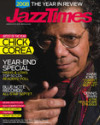 web site says that a Boston company, Madavor Media, has acquired JazzTimes. It describes Madavor as "a market-leading enthusiast publishing and trade-show group."
web site says that a Boston company, Madavor Media, has acquired JazzTimes. It describes Madavor as "a market-leading enthusiast publishing and trade-show group."
Jazz Times announced in early June that it was temporarily suspending publication. A New York Times report today says that Madavor bought the JazzTimes brand and assets from publisher Glenn Sabin. Sabin's father, Ira, founded the publication in 1970 as Radio Free Jazz, a newsletter that he transformed into a tabloid-sized paper and, 19 years ago, a slick magazine that reached a circulation of more than 100,000. JazzTimes won this year's Jazz Journalists Association award as best jazz magazine, an honor it received for several years.
The New York Times story quotes JazzTimes editor-in-chief Lee Mergner as saying that contributors will get fees the magazine owes them. Mergner told the Times that he and managing editor Evan Haga will remain aboard and use the same staff of free-lance contributors.
More than a month ago, we wrote:
With the suspension last year of the Canadian magazine Coda, the absorption of Britain's Jazz Review by Jazz Journal and the conversion of JazzIz to a quarterly, jazz listeners' choices of major print information about the music are disappearing fast. The question, unanswerable at this point, is whether web sites and blogs can provide the same depth and width of coverage generations have received from jazz magazines. This is a small manifestation of the larger challenge facing free societies as newspapers shrink or disappear. A democracy can only suffer from diminution and fragmentation of the flow of information upon which we base our judgments.Let us hope that JazzTimes survives its reorganization. More important, let us hope that we do not lose news organizations serving mass audiences. They help bind us together.
Congratulations to JazzTimes.
Martial Solal Live at the Village Vanguard (CamJazz). The CD's subtitle is I Can't Give You Anything but Love. In this recital, the French pianist gives his listeners 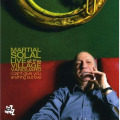 more than love. We get architectural thinking, drollery, daring, virtuosity that includes astonishing mastery of meter, and chord voicings that illuminate like fireworks. Solal was 80 when this was recorded in 2007. His command of the instrument and his intellectual resources were in full operation. He interprets seven standards with insights into the natures of the songs, deep harmonic substance and inflections of his endearing wit. Among other delights, following his deep ruminations during "'Round Midnight" he makes pointed allusions to other Thelonious Monk compositions; integrates crippled cadences into "On Green Dolphin Street;" plays abstractions of the melody, astringent parallel harmonies and stride flurries in "Corcovado." Solal has always managed to integrate profundity and entertainment without sacrificing anything of either. Two of his own compositions, "Ramage" (French for "flower patterns") and "Centre de Gravite," have characteristics suggested by their titles and give the impression of pure improvisation, whether or not they are.
more than love. We get architectural thinking, drollery, daring, virtuosity that includes astonishing mastery of meter, and chord voicings that illuminate like fireworks. Solal was 80 when this was recorded in 2007. His command of the instrument and his intellectual resources were in full operation. He interprets seven standards with insights into the natures of the songs, deep harmonic substance and inflections of his endearing wit. Among other delights, following his deep ruminations during "'Round Midnight" he makes pointed allusions to other Thelonious Monk compositions; integrates crippled cadences into "On Green Dolphin Street;" plays abstractions of the melody, astringent parallel harmonies and stride flurries in "Corcovado." Solal has always managed to integrate profundity and entertainment without sacrificing anything of either. Two of his own compositions, "Ramage" (French for "flower patterns") and "Centre de Gravite," have characteristics suggested by their titles and give the impression of pure improvisation, whether or not they are.
Because of his command of the piano, Solal is often compared with Art Tatum. Fair enough; what jazz pianist of his generation with the technical ability to emulate Tatum was not under the influence of that master? Bud Powell is less often mentioned as a component of Solal's musical makeup, but on this night at the Vanguard, Powell was a beatific presence peering out of Solal's solos. A listener might also hear traces of other pianists of several eras and styles; Bill Evans, Teddy Wilson, Al Haig or Solal's young countryman Michel Petrucciani. Still, when this CD ends, Solal has confirmed yet again that he is unclassifiable, a thorough original.
Here's a look at Martial Solal in performance with a trio in a video pastiche. YouTube does not identify the sidemen, but they appear to be the Moutin brothers, Francois on bass and Louis on drums.
It was 97 degrees today and time to get the apricots off the tree. In 2008, the tree produced two apricots. This year, it compensated, loading its branches with huge fruits. Eat your hearts out. Or, better, visit Rifftides World Headquarters and eat an apricot. The two bushels are perhaps a fifth of the tree's output.
What does this have to do with jazz? It's summertime. Here's Sidney Bechet.
In Barcelona, there is a baritone saxophonist named Joan Chamorro. As might be expected of a young player of his instrument, he is under the spell of Harry Carney, Gerry Mulligan and Pepper Adams. I can find no recordings under his own name, although here and here, Chamorro is listed as a sideman. Jordi Pujol sent the Rifftides staff a message in which he mentioned that this year his Fresh Sound label will release a CD with Chamorro as leader. Based on what I have heard of his playing, that seems something to anticipate.
On YouTube and Google there several videos of Chamorro at work with his quartet. In the lengthy clip below, he pays tribute to Mulligan with a medley of quartet pieces. The first number, incomplete, is Ben Webster's blues "Go Home," followed by "Bernie's Tune," "Makin' Whoopee" and "Love Me or Leave Me." The other musicians are Toni Belenguer, trombone; David Mengual, bass; and David Xirgu, drums. Despite their adherence to the form of the Mulligan pieces, the individuality of Chamorro and the others leaps off the screen and out of the speakers, particularly in the final choruses of "Love Me or Leave Me." Unfortunately, the performance is summarily executed before it finishes. The sloppy production is typical of web videos, but we get spirited playing that indicates more good work to come from Spain.
Len Dobbin, a man of many parts in Montreal, died last night. Among his other roles, over the years Mr. Dobbin was a broadcaster, reviewer, photographer and producer intimately involved in the Canadian jazz scene. For details, go here. Len was a frequent and knowledgeable correspondent to Rifftides. The Rifftides staff will miss him.
(This item originally appeared in Rifftides on July 19, 2005)
A Little "Rifftide" Geneology
Annie Kuebler, the Mary Lou Williams archivist at the Rutgers Institute of Jazz Studies, gives us further insights into "Rifftide." That is the 1945 Coleman Hawkins recording that inspired the name of this blog. She does not say that Hawkins stole the tune from Williams, only that it is likely to have been lodged in his mind when he played on a little-known record date with Mary Lou a couple of months before his own session. In the mid-forties, Hawkins and Williams were major swing era musicians encouraging and aiding the younger players who were developing bebop. Hawkins gave Thelonious Monk one of his most important early jobs as a pianist. Wiliams had a profound influence on the  new music's pianists. She told Ira Gitler in an interview for his book Swing To Bop, "We were inseparable, Monk, Bud Powell and I. We were always together every day, for a long time."
new music's pianists. She told Ira Gitler in an interview for his book Swing To Bop, "We were inseparable, Monk, Bud Powell and I. We were always together every day, for a long time."
Here is the note Ms. Kuebler sent us about "Rifftide."
On December 15, 1944, Moe Asch recorded six cuts titled Mary Lou Williams and Her Orchestra in New York City. Williams's arrangement of "[Oh] Lady Be Good" is nearly identical to Hawkins's "Rifftide"--and one doesn't need a musicologist to explain it. It just takes a listen. The only real difference is the breaks to accommodate the various musicians. Originally recorded on 78 rpm Asch 552-3 as a three record set, the recording is now available on CD on the Chronological Classics Series # 1021, Mary Lou Williams 1944 -1945.The personnel for four of the cuts is Hawkins - tenor sax; Joe Evans - alto; Claude Green - clarinet; Bill Coleman - trumpet; Eddie Robinson - bass; Denzil Best - drums; and, of course, Williams on piano.
Obviously, this recording precedes "Rifftide," attributed to Hawkins, from Hollywood Stampede on February 23, 1945. I don't believe enough time had passed that Hawkins forgot the source, but that's an opinion. Since my music manuscript archivist career began with Duke Ellington's Collection, I am not judgmental about these things -- just like to lay the facts out. In such matters, I am always reminded of Juan Tizol's reply when asked if Ellington stole songs, "Oh, he stole. He'd steal it from his own self."
Hope this helps. Thank for naming your website after a great underrated artist's arrangement.
Before she joined the Institute for Jazz Studies five years ago, Annie Kuebler spent twelve years at the Smithsonian Institution. There, among many other achievements, she accomplished the massive task of organizing the manuscripts in the Smithsonian's Duke Ellington collection. Her contributions to preserving large segments of American art and culture are invaluable. Thanks, Annie
To my knowledge, there is no video of Coleman Hawkins or Mary Lou Williams playing "Rifftide" or "Oh, Lady Be Good" and certainly not "Hackensack," Thelonious Monk's appropriation or adaptation of the line. So, we'll have to settle for Stan Getz and John Coltrane accompanied by Oscar Peterson, Paul Chambers and Jimmy Cobb. This was 1960 in Dusseldorf. There are several dubs of this clip floating around the internet. This one has the clearest picture and sound.
For some time--years--I have been bothered by the further deterioration of a craft that too often has not achieved the status of serious criticism. I write, sad to say, of jazz reviewing, in which assignments all too often go to the lowest bidder, or to no bidder. These days, they go less frequently than ever to those who know something about music or are willing to learn about it, or who have qualifications beyond an eagerness to get free records or free admittance.

When a Canadian acquaintance sent me the Montreal Gazette review of last week's Maria Schneider concert at the Montreal International Jazz Festival, I thought it was a spoof of incompetent, malevolent, reviewing. It is not. It is the real thing, incompetent and malevolent. It is also misogynist.
Here are the headline, byline and first few sentences:
Jazz fest 2009: Maria with the long bare arms
By JEFF HEINRICH
07 02 09My high-school jazz band was never conducted by a woman, let alone a middle-aged American blonde with a penchant for sleeveless black tops that show off her Pilates-styled arms. But then, again, if my high-school jazz band had been conducted by such a woman, I might have been too distracted and never become a gifted clarinet player. Actually, that's a lie; I gave up the clarinet pretty early. So what was so bothersome about the show Maria Schneider and her jazz orchestra gave the other night (Tuesday) at Théâtre Maisonneuve? Well, a couple of things: Schneider's irritatingly stiff body-language and the equally stiff sound of her musicians, as excruciating visually and aurally as your run-of-the-mill high-school jazz band. It was creepy, the way the soloists schlumped across the stage to do their number then schlumped back to their seats and their music stands, like adolescents in uniforms going through the paces.
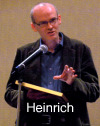 The in-depth misogynism comes in the rest of the article. To read the whole thing, go here. Then scroll down to read responses from readers of the Gazette, nearly all of whom know more about Mr. Heinrich's subject than he does and all of whom are more articulate and civil, even the one who wrote, "Your an idiot." To paraphrase many of them, what were the editors of the Gazette thinking when they assigned Mr. Heinrich to review something for which he had a priori contempt? What were they thinking when they examined his copy before they published it? Did they put it through the editorial process at all? Any answer to those questions is disturbing.
The in-depth misogynism comes in the rest of the article. To read the whole thing, go here. Then scroll down to read responses from readers of the Gazette, nearly all of whom know more about Mr. Heinrich's subject than he does and all of whom are more articulate and civil, even the one who wrote, "Your an idiot." To paraphrase many of them, what were the editors of the Gazette thinking when they assigned Mr. Heinrich to review something for which he had a priori contempt? What were they thinking when they examined his copy before they published it? Did they put it through the editorial process at all? Any answer to those questions is disturbing.
Mr. Heinrich's level of gratuitous nastiness is not typical of most jazz reviewers. All too often his level of ignorance of the subject is typical in both specialty and general publications. There are jazz critics who pride themselves on writing from a base of knowledge, perception, taste and fairness. They have worked, studied, researched and listened hard to achieve that standard. There are, alas, countless editors and publishers who do not hold their staff writers or free lance contributors to high professional values. That is bad for everyone--readers, listeners, musicians and, ultimately, newspapers, magazines and the journalism profession.
As jazz magazines go out of business and coverage budgets at general circulation publications dry up, one part of conventional journalism wisdom is that the web, specifically bloggers on the web, will take up the slack. Please don't let it disturb you if I point out that most bloggers work for nothing more than the challenge, the thrill, the contacts or the loss-leading benefits of using their blogs as adjuncts to whatever they do for a living. It would be a mistake to count on them (us) to provide the standards and oversight that print publishers are unwilling or unable to observe and practice. In journalism as in the rest of life, generally you get what you pay for.
Asked to define jazz, Louis Armstrong replied, "If you have to ask what it is, you'll never know." That's one answer. Here's another, provided by Dizzy Gillespie, Sonny Rollins, Hank Jones, Rufus Reid and Mickey Roker at Gillespie's 70th birthday concert on October, 21, 1987. The composition is Gillespie's blues "Wheatleigh Hall." In the preamble, Gillespie and Rollins praise one another, then Willis Conover introduces the performance. If you have full-screen capability on your computer, please do yourself a favor and use it. I have watched and listened to this four times tonight and will play it again before I turn in.
To find the 1957 Gillespie-Rollins recording of "Wheatleigh Hall," which also has Gilespie duets with Sonny Stitt, click here.
Have a good Sunday.
(An annual Rifftides reminder)
Those who would give up essential Liberty, to purchase a little temporary Safety, deserve neither Liberty nor Safety.--Benjamin Franklin
America will never be destroyed from the outside. If we falter and lose our freedoms, it will be because we destroyed ourselves.--Abraham Lincoln
Sheila Jordan has a farmhouse retreat in Upstate New York where the 80-year-old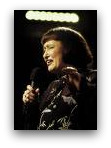 singer goes to develop new music. In The New York Times this week, Lisa A. Phillips wrote a charming story about Jordan and her country life. Here is a sample:
singer goes to develop new music. In The New York Times this week, Lisa A. Phillips wrote a charming story about Jordan and her country life. Here is a sample:
"When I come up here," she said, "I feel totally undressed musically. I feel I can try out any kind of idea I have."
On her five and a quarter acres of land atop Canady Hill, her only close neighbors have been the cows the farmer next door once kept. "I called them the bebop cows," Ms. Jordan said. "They didn't like ballads. If I sang them a slow tune, they left. If I sang bebop, they came running over."
To read the whole thing, go here. Do not miss the audio slide show embedded in the article.
Here is Sheila during a Austrialian tour in a tribute to one of her heroes, Billie Holiday. Mike Nock's trio accompanies her.
When the video clip ends, you will see links to other Jordan performances on YouTube.
If all of July is like this, I'll be a happy cyclist. My Italian friend Vigorelli Bianchi and I did 22 morning miles. The air and light had a crystalline quality more usual In October than summer. The cherry crop looks splendid,
22 morning miles. The air and light had a crystalline quality more usual In October than summer. The cherry crop looks splendid,  loading the trees so heavily that in places the branches bowed low near enough to the road that I could almost have plucked the fruit as I rode by. This is the stage at which cherry growers pray for no rain.
loading the trees so heavily that in places the branches bowed low near enough to the road that I could almost have plucked the fruit as I rode by. This is the stage at which cherry growers pray for no rain.
Thinners are in the apple trees making room for the fall fruit to develop. Th e orchards have all the earmarks of a bumper apple crop.
e orchards have all the earmarks of a bumper apple crop.
Fruit workers waved and smiled as I passed, approaching motorists nodded and lifted fingers from their steering wheels in greeting, dogs barked more out of a sense of duty than intent to pursue, and not one pickup truck tried to run me into the ditch. It was one of those rides when I felt stronger at the end than the beginning. It was great out there.
I had to tell someone.
AJ Ads
AJ Blogs
AJBlogCentral | rssculture
Terry Teachout on the arts in New York City
Andrew Taylor on the business of arts & culture
rock culture approximately
Laura Collins-Hughes on arts, culture and coverage
Richard Kessler on arts education
Douglas McLennan's blog
Dalouge Smith advocates for the Arts
Art from the American Outback
Chloe Veltman on how culture will save the world
For immediate release: the arts are marketable
No genre is the new genre
David Jays on theatre and dance
Paul Levy measures the Angles
Judith H. Dobrzynski on Culture
John Rockwell on the arts
innovations and impediments in not-for-profit arts
Jan Herman - arts, media & culture with 'tude
dance
Apollinaire Scherr talks about dance
Tobi Tobias on dance et al...
jazz
Howard Mandel's freelance Urban Improvisation
Focus on New Orleans. Jazz and Other Sounds
Doug Ramsey on Jazz and other matters...
media
Jeff Weinstein's Cultural Mixology
Martha Bayles on Film...
classical music
Fresh ideas on building arts communities
Greg Sandow performs a book-in-progress
Harvey Sachs on music, and various digressions
Bruce Brubaker on all things Piano
Kyle Gann on music after the fact
Greg Sandow on the future of Classical Music
Norman Lebrecht on Shifting Sound Worlds
Joe Horowitz on music
publishing
Jerome Weeks on Books
Scott McLemee on books, ideas & trash-culture ephemera
theatre
Wendy Rosenfield: covering drama, onstage and off
visual
Public Art, Public Space
Regina Hackett takes her Art To Go
John Perreault's art diary
Lee Rosenbaum's Cultural Commentary
